Kashk facts for kids
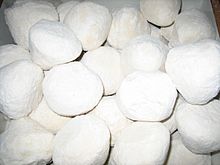
|
|
| Alternative names | Qurut, Aaruul (or khuruud), chortan, dried yogurt, jameed, shilanch, kishk, qqet, kurut |
|---|---|
| Type | Gruel, cheese |
| Place of origin | Central Asia |
| Region or state | Iran, Bashkortostan Caucasus, Central Asia, Kurdistan, Middle East (Levant and Arabian Peninsula), Tatarstan |
| Main ingredients | Yogurt, salt, sugar |
| Other information | %21.60- 39.31 water, % 4.5-23.5 fat, %31.22-50.68 protein ve %2.84-13.19 salt |
Kashk (Persian: کشک Kašk) is a special type of dried dairy product. It is also known by many other names, like qurut or aaruul. People in countries like Iran, Afghanistan, Turkey, and Mongolia use kashk in their cooking.
Kashk is made from thick yogurt or sour milk. It is shaped and then left to dry. You can find it in different forms, such as small balls, strips, or chunks.
There are three main kinds of food products called kashk. Some are made from milk products like yogurt or cheese. Others are made from barley broth, bread, or flour. A third type mixes cereals with curdled milk.
Contents
What is Kashk?
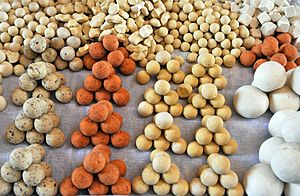
Long ago, kashk was a porridge made from grains. These grains were fermented with whey (the liquid part of milk) and dried in the sun. This old form of kashk lasted a long time. It was a great food for farmers, soldiers, and travelers, especially in winter.
Today, kashk is often made from dried buttermilk. You can crumble it and mix it with water to make a paste. This powder helps to thicken soups and stews. It also makes them taste better. Drying the kashk helps it stay fresh for a long time.
Kashk is also a key ingredient in a famous Iranian dish. This dish is called kashk-e bademjan, and it features eggplant.
Kashk Around the World
Kashk is popular in many countries. These include Iran, Iraq, Syria, Egypt, the Caucasus, and Turkey. Because so many different languages are spoken in these areas, kashk has many names.
For example, it is called kashk or kishkh in some places. In others, it is known as qurut. Other names include jameed, chortan, and aaruul. The name chortan is even mentioned in an old Armenian story from the 1800s.
Some historians believe the first mention of kashk was by an Armenian historian. In a Persian book from the 900s, Shahnameh, kashk meant "barley flour." It also meant a mix of cracked wheat and barley.
How is Kashk Made?
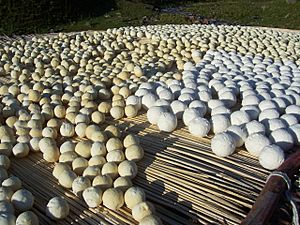
You can make dried yogurt, or qurut, in a traditional or modern way. For the modern method, sour yogurt is blended until it is smooth. Then, it is boiled and strained. It ferments in a warm oven for a few days. After that, the water is drained, and salt is added to make the kashk. The liquid that is drained off can be used to make qaraqurut, which is dried black whey.
For traditional qurut, water is added to full-fat yogurt. This mix is put into a goatskin bag. The bag is swung back and forth until the milk separates. It forms a type of butter and buttermilk. The buttermilk is then boiled and drained. This creates curd, which is dried in the sun for several weeks to make qurut.
When kashk is made with grain, like in Armenian, Arab, and Turkish cuisines, strained yogurt is added to grain. This mixture is stored until it ferments. After drying in the sun for over a week, it is rubbed into a coarse powder. This powder is then sifted.
Kashk in Different Regions
Kashk in the Caucasus
In Armenia, Matzoon is a common ingredient. In Georgia, it is called mats'oni. When matsun is churned, it separates from the buttermilk. If you boil and churn the buttermilk, you get a type of ricotta cheese. The dried cheese clots are called chortan. In Armenian, chor means "dry" and tan means "buttermilk."
In Azerbaijan, qurut is made in a similar way. It uses strained yogurt. Yogurt (qatiq) is made from fresh milk and then strained to make suzma qatiq. After the buttermilk is separated from the butter, the buttermilk curds are shaped into small balls. These are then dried in the sun.
In western Azerbaijan, boiled flat dough is layered with a white qurut sauce and chicken. This dish is called Azerbaijani xəngəl.
Kashk in Central Asia
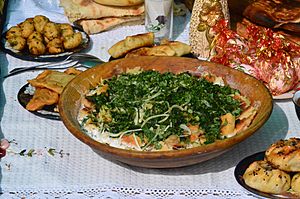
Qurut dissolved in water is a main ingredient in qurutob. Some people think qurutob is the national dish of Tajikistan. In Afghanistan, a main dish is kichree qurut. It is made with mung beans, rice, and qurut dissolved in water.
Sometimes, qurut is salted. In Mongolia, aaruul can be flavored. It also comes in many different shapes, sizes, and textures, from soft to very hard.
Kashk in Iran
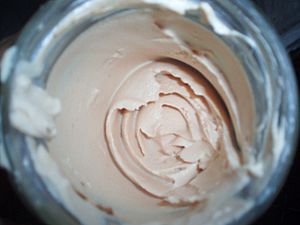
Kashk has been a very important food in Iran for thousands of years. In modern Iran, kashk is a thick, whitish liquid. It looks a bit like whey or sour cream. It is used in traditional Persian and Kurdish cuisine. You can find it in dishes like ash reshteh and kashk e badamjan.
Kashk is sold as a liquid or in a dried form. The dried form needs to be soaked in water before you can use it for cooking. Traditionally, kashk was made from the leftovers of cheese-making. First, butter is taken from milk. The rest is doogh, which is the base for kashk. The water is removed from this whitish drink, and what is left is kashk. This can then be dried.
Kashk in Turkey
In Turkey, kashk is a dried yogurt product. It is also known as keş peyniri, kurut, or taş yoğurt. How it is made and what it contains can change depending on the region. In western and northern Turkey, it is often seen as a type of cheese because of its shape and white color.
In eastern Turkey, kurut is made from skimmed yogurt. This yogurt comes from the whey left over after making butter. It is then crushed or rolled. In parts of southeastern Turkey, where many Kurdish people live, it is called keşk. All types of this dairy product are salty. It is used in soups, keşkek, and erişte.
There is also a similar dried food called tarhana. It is made from a fermented mix of grain and yogurt or fermented milk. It is very much like kishk from the Levant.
Kashk in the Levant and Arabian Peninsula
In Lebanon, Jordan, the Arabian Peninsula, and Syria, kishk is a powdery cereal. It is made from burghul (cracked wheat) fermented with milk and laban (yogurt). This yogurt usually comes from goat milk. It is easy to store and is a valuable food for people in villages during winter.
Kishk is made in early autumn after burghul is prepared. Milk, laban, and burghul are mixed well. They are left to ferment for nine days. In Lebanon, salt is added, and the mix ferments in large clay jars for up to three weeks. It is kneaded by hand every morning. When it is ready, the kishk is spread on a clean cloth to dry. This often happens on rooftops in the countryside. Finally, it is rubbed until it becomes a powder, sieved, and stored in a dry place.
In Lebanese cooking, kishk is still used today. It is mixed with tomato paste and used as a topping for manakish. This is a type of flatbread cooked in an oven and eaten for breakfast or lunch. Traditionally, it was also served with eggs, as a kibbeh stuffing, or in a soup. Sometimes, it was cooked with lamb meat fried in its own fat.
In Jordan, a dried yogurt similar to kashk is called jameed. It is commonly used there. In other parts of the Levant, similar products are called drained labneh.
See also
 In Spanish: Kashk para niños
In Spanish: Kashk para niños

